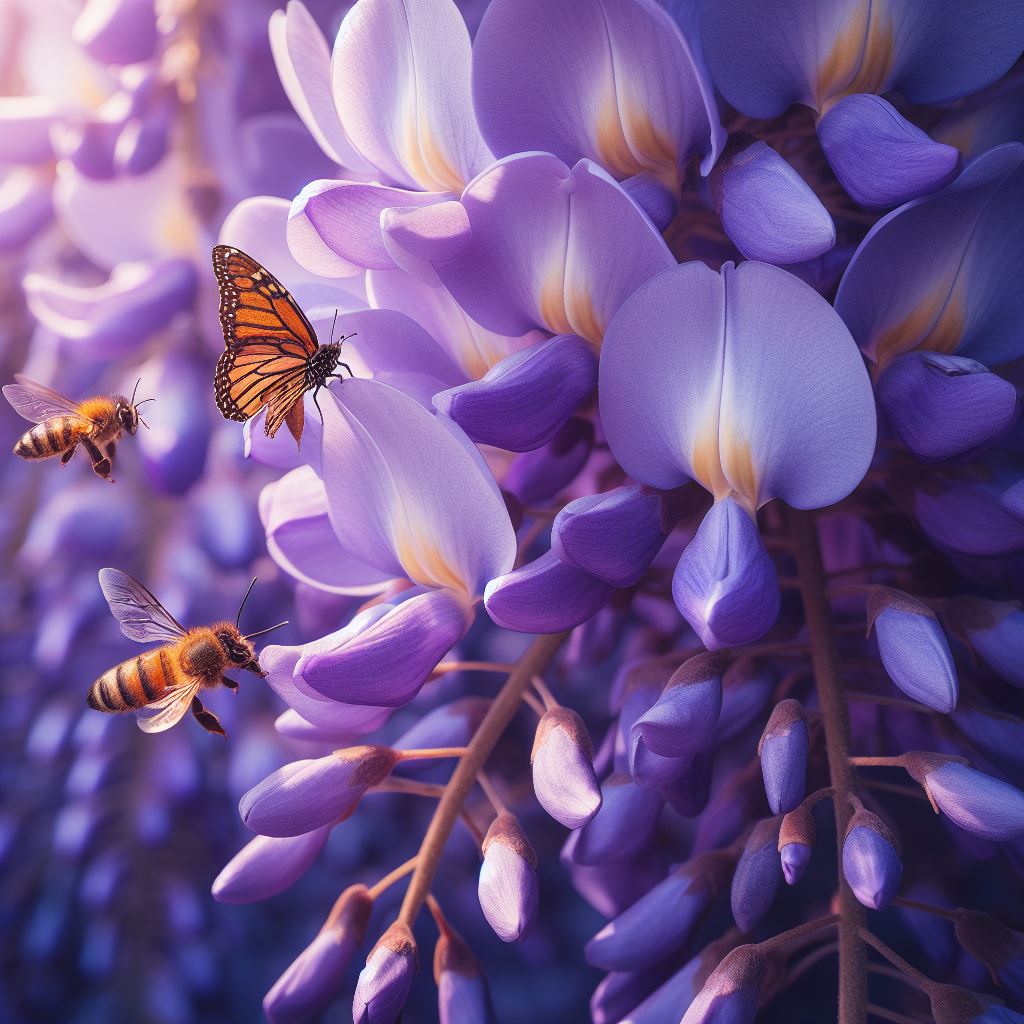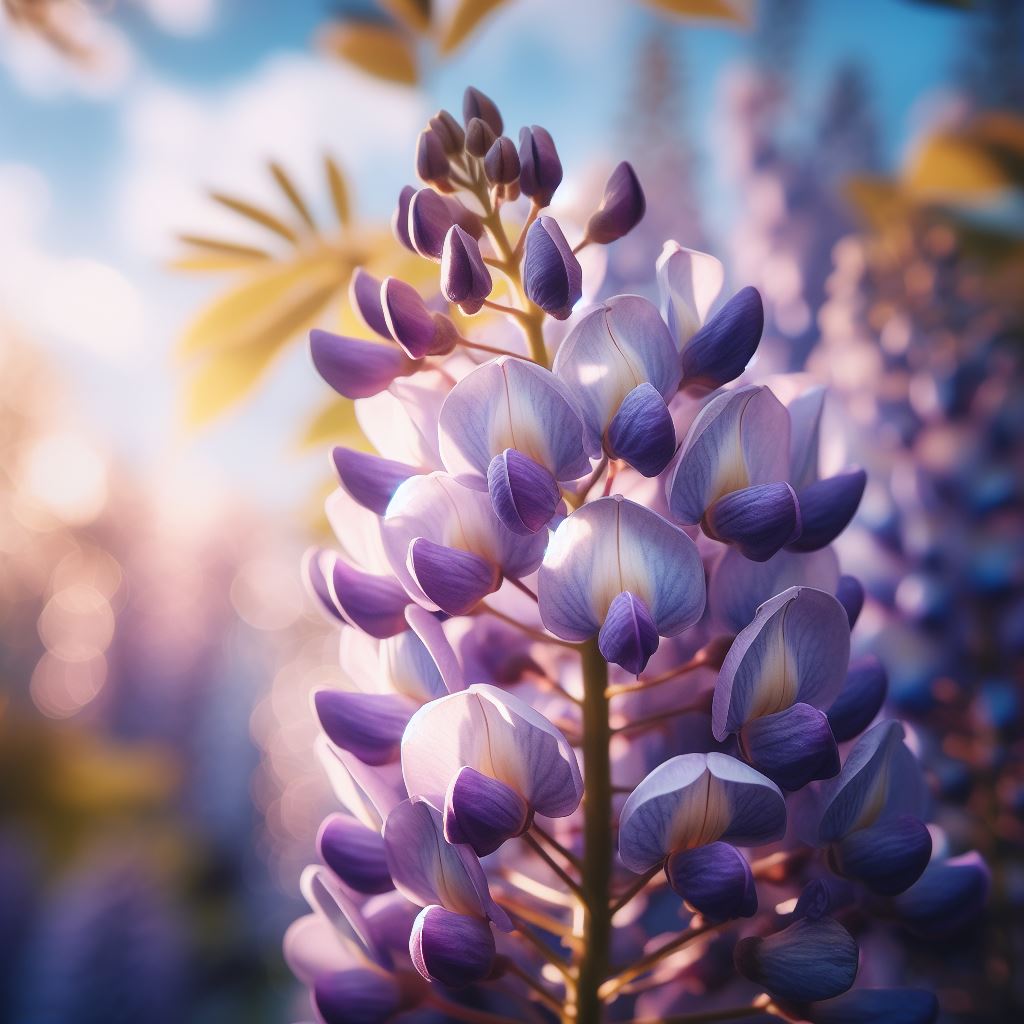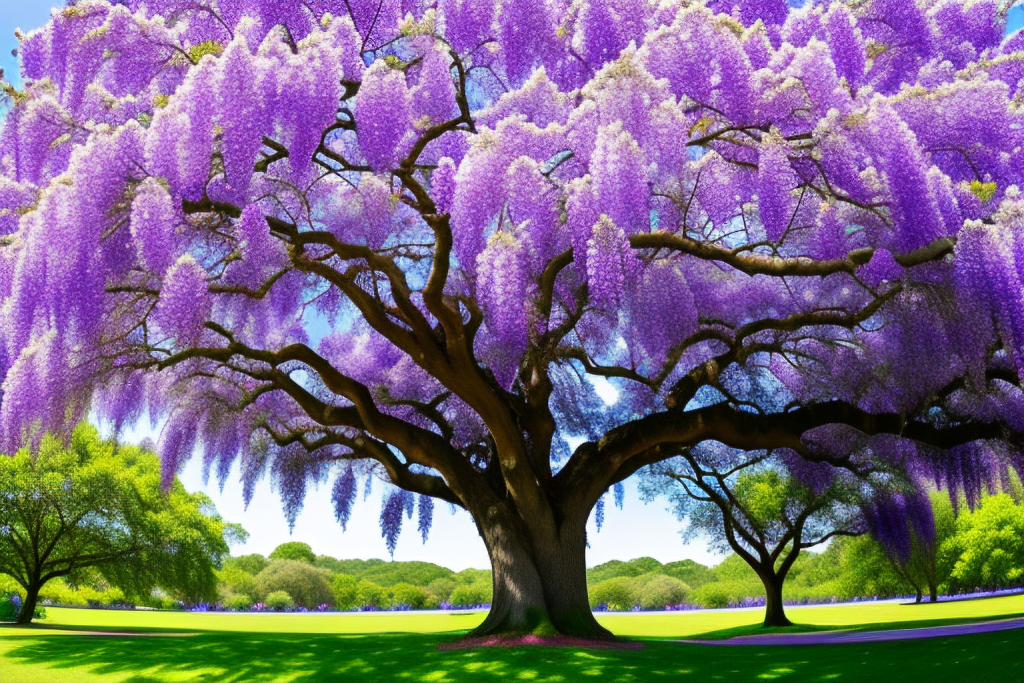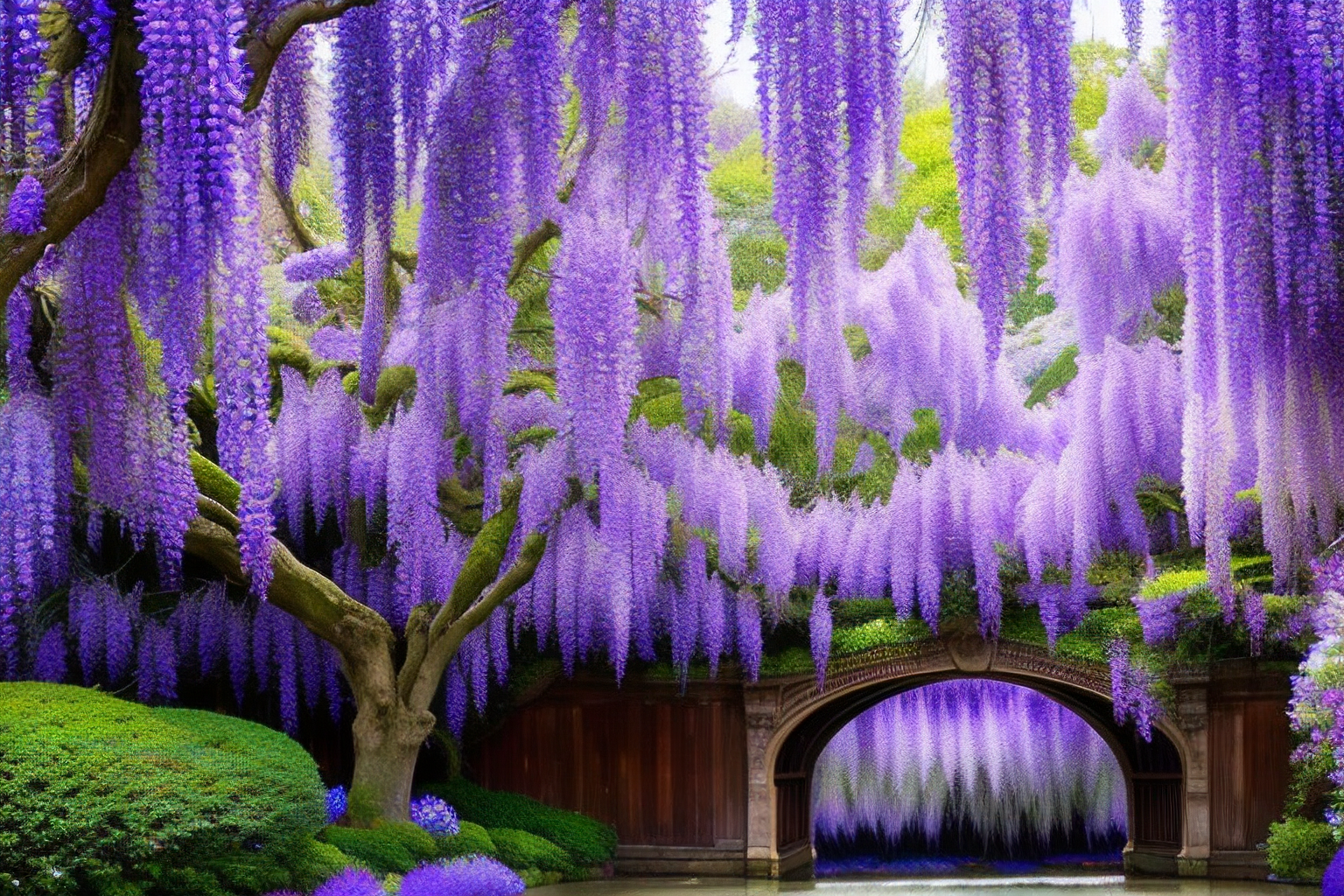Experience the awe-inspiring splendor of Blue Wisteria plants and unlock the secret to creating a garden that is truly mesmerizing. These enchanting plants have the power to transform your outdoor space into a breathtaking oasis of color and fragrance. With their delicate blue blooms and cascading vines, Blue Wisteria plants are a sight to behold.
Imagine stepping into your garden and being greeted by a sea of vibrant blue flowers, their sweet scent filling the air. Blue Wisteria plants have the ability to captivate your senses and transport you to a world of beauty and tranquility. Whether you have a small balcony or a sprawling backyard, these plants can add a touch of magic to any space.
But the beauty of Blue Wisteria plants goes beyond their aesthetic appeal. They also attract butterflies, bees, and other pollinators, making your garden a haven for wildlife. The vibrant colors and intoxicating fragrance of these plants create a sensory experience that is truly unforgettable.
With their graceful vines and stunning flowers, Blue Wisteria plants can be trained to climb trellises, pergolas, and other support structures, creating a stunning display that is sure to impress. Imagine sitting beneath a canopy of blue blooms, sipping your morning coffee or enjoying a peaceful afternoon in the shade.
Whether you’re a seasoned gardener or just starting out, Blue Wisteria plants are a must-have addition to your garden. With the right care and attention, these plants will reward you with years of beauty and joy. So, why wait? Discover the enchanting beauty of Blue Wisteria plants and embark on a journey to create a garden that will leave you and your guests in awe.
The Origin of Blue Wisteria

The origin of blue wisteria plants is deeply rooted in history and holds significant cultural significance. These enchanting plants have captivated people’s hearts for centuries with their stunning beauty and delicate blooms. Blue wisteria plants are believed to have originated in China and were later introduced to Japan, where they became a symbol of beauty, grace, and longevity.
Blue wisteria plants are available in a variety of species and cultivars, each with its own unique characteristics. Some popular varieties include the Blue Chinese Wisteria Tree, Blue Moon Wisteria, and Blue Wisteria Tree. These plants are known for their cascading clusters of fragrant, blue-violet flowers that create a mesmerizing display in any garden or landscape.
Throughout history, blue wisteria plants have been celebrated in art, literature, and cultural traditions. They have been depicted in paintings, poetry, and even used as inspiration for architectural designs. The delicate and ethereal beauty of blue wisteria has made it a beloved subject for artists and a symbol of elegance and grace.
Whether you are a gardening enthusiast or simply appreciate the beauty of nature, learning about the origins and history of blue wisteria plants can deepen your appreciation for these magnificent blooms. From their cultural significance to the wide range of varieties available, blue wisteria plants continue to enchant and inspire people around the world.
Growing and Caring for Blue Wisteria
Growing and caring for blue wisteria plants requires some expert tips and advice to ensure their successful growth and maintenance. Here are some key factors to consider when cultivating these beautiful plants:
- Ideal Planting Conditions: Blue wisteria thrives in well-drained soil with full sunlight exposure. It is important to choose a location that provides ample space for the plant to grow and climb.
- Pruning Techniques: Regular pruning is essential for maintaining the health and shape of blue wisteria. Prune during the dormant season to remove dead or damaged branches and promote new growth. It is also important to prune after flowering to encourage the development of new blooms.
- Watering: Blue wisteria plants require regular watering, especially during dry periods. However, be cautious not to overwater, as excessive moisture can lead to root rot.
- Fertilizing: Apply a balanced fertilizer during the growing season to provide essential nutrients to the plant. Follow the instructions on the fertilizer package for proper application.
- Support Structures: Blue wisteria plants are vigorous climbers and require sturdy support structures such as trellises, pergolas, or arbors. Make sure to provide adequate support for the plant to grow and flourish.
By following these expert tips and advice, you can ensure the successful growth and care of your blue wisteria plants. With the right planting conditions, pruning techniques, and proper care, you can enjoy the stunning beauty and fragrance of these magnificent plants in your garden.
Creating a Stunning Blue Wisteria Display
Creating a stunning blue wisteria display in your garden is a wonderful way to showcase the beauty of these enchanting plants. There are several creative ideas and design tips that can help you make the most of your blue wisteria.
One popular option is to use trellises and pergolas as support structures for your blue wisteria. These structures not only provide a sturdy base for the vines to climb, but they also add an architectural element to your garden. You can choose from a variety of trellis and pergola designs, from simple and minimalist to intricate and ornate, depending on your personal style and the overall aesthetic of your garden.
Another way to enhance the display of your blue wisteria is through companion planting. By selecting plants that complement the color and form of the wisteria blooms, you can create a harmonious and visually appealing garden landscape. Some popular companion plants for blue wisteria include roses, lavender, and clematis. These plants not only add beauty to the garden, but they also attract beneficial insects and pollinators, creating a thriving ecosystem.
When designing your blue wisteria display, it’s important to consider the placement and spacing of the plants. Blue wisteria vines can grow quite long and can become heavy with blooms, so it’s essential to provide adequate support and space for them to flourish. Additionally, ensure that the wisteria receives enough sunlight and water, as these are crucial factors for its growth and blooming.
By exploring these creative ideas and design tips, you can create a stunning blue wisteria display that will captivate and delight all who visit your garden. Whether you choose to use trellises and pergolas or incorporate companion planting, the beauty of blue wisteria will truly transform your outdoor space into a breathtaking oasis of color and fragrance.
Choosing the Right Support Structures

When it comes to showcasing the beauty of blue wisteria plants in your garden, choosing the right support structures is crucial. These structures not only provide stability and support for the vines, but they also add an element of architectural charm to your outdoor space. Let’s explore the various options available and learn how to select the best one for your garden.
1. Arbors: Arbors are a popular choice for blue wisteria plants as they create a stunning entrance or focal point in your garden. These structures typically have an arched or curved design, allowing the wisteria vines to gracefully cascade over them. When choosing an arbor, consider the size and height of your blue wisteria tree to ensure a proper fit.
2. Arches: Similar to arbors, arches also provide a beautiful framework for blue wisteria plants. These structures have a curved shape that creates a sense of grandeur and elegance. When selecting an arch, make sure it is sturdy enough to support the weight of the wisteria vines and consider the overall aesthetic of your garden.
3. Trellises: Trellises are another excellent option for supporting blue wisteria plants. These structures consist of a series of interconnected grids or panels, providing ample space for the vines to climb and bloom. When choosing a trellis, opt for one that is made of durable materials such as metal or wood and ensure it is tall enough to accommodate the height of your wisteria tree.
4. Pergolas: If you’re looking to create a shaded area in your garden, a pergola combined with blue wisteria plants is the perfect choice. Pergolas are larger structures that feature a series of overhead beams, providing a framework for the wisteria vines to grow and create a canopy of beautiful blooms. Consider the size and design of the pergola to ensure it complements your garden’s layout.
Remember, when selecting a support structure for your blue wisteria plants, consider the overall aesthetic of your garden, the size and height of your wisteria tree, and the durability of the structure. By choosing the right support, you can create a visually stunning display that will leave your garden visitors in awe.
Companion Plants for Blue Wisteria
When it comes to creating a harmonious garden landscape, choosing the right companion plants for your blue wisteria is essential. Not only do companion plants enhance the beauty of the wisteria, but they also provide a balanced and complementary backdrop for these stunning vines.
Here are some of the best companion plants that can enhance the beauty of blue wisteria:
- Lavender: Planting lavender alongside blue wisteria creates a stunning color combination and adds a delightful fragrance to your garden.
- Clematis: The delicate blooms of clematis intertwine beautifully with the cascading flowers of blue wisteria, creating a visually captivating display.
- Roses: Pairing blue wisteria with roses creates a romantic and elegant garden setting. Choose roses in complementary colors to enhance the overall aesthetic.
- Peonies: The lush and vibrant blooms of peonies provide a striking contrast to the delicate flowers of blue wisteria, creating a visually dynamic garden landscape.
When selecting companion plants for blue wisteria, consider their growth habits, sunlight requirements, and soil preferences. Ensure that the companion plants do not compete with the wisteria for resources and space. By carefully selecting and planting companion plants, you can create a harmonious and breathtaking garden that showcases the awe-inspiring splendor of blue wisteria.
Solving Common Blue Wisteria Challenges
Solving Common Blue Wisteria Challenges
Blue wisteria plants, with their stunning blooms and delicate foliage, can sometimes face challenges that affect their health and growth. It is important for gardeners to be aware of these common issues and know how to address them effectively. By identifying and troubleshooting these challenges, you can ensure that your blue wisteria plants thrive and continue to enchant your garden.
Pests are one of the main challenges that blue wisteria plants may encounter. Common pests that can affect these plants include aphids, scale insects, and caterpillars. These pests can cause damage to the leaves and flowers, leading to stunted growth and reduced blooming. To combat these pests, you can use insecticidal soaps or natural predators such as ladybugs to control their population.
In addition to pests, blue wisteria plants are also susceptible to certain diseases. Powdery mildew, a fungal infection, is a common issue that affects the leaves and stems of these plants. To prevent powdery mildew, ensure proper air circulation around the plants and avoid overhead watering. If the infection occurs, you can use fungicides specifically formulated for powdery mildew.
Environmental factors can also pose challenges to blue wisteria plants. These plants prefer full sun and well-drained soil. If they are not provided with the ideal growing conditions, they may experience stunted growth and reduced blooming. It is important to ensure that the soil is well-drained and enriched with organic matter. Regular watering and proper pruning can also help maintain the health and vigor of blue wisteria plants.
By being aware of these common challenges and taking appropriate measures to address them, you can ensure that your blue wisteria plants thrive and continue to add beauty and charm to your garden.
Enjoying the Wonders of Blue Wisteria

When it comes to blue wisteria, the sensory experience is truly awe-inspiring. From the moment you encounter its captivating fragrance, you’ll be transported to a world of tranquility and beauty. The scent of blue wisteria is delicate yet powerful, filling the air with a sweet and floral aroma that is simply enchanting.
But the wonders of blue wisteria don’t stop at its fragrance. The sight of cascading blooms is a sight to behold. As the flowers unfurl, they create a mesmerizing display of vibrant blue hues, cascading down like a waterfall of color. Whether you choose to grow blue wisteria on a trellis, pergola, or any other support structure, the sight of these blooms will leave you in awe.
To fully enjoy the wonders of blue wisteria, take the time to sit back and immerse yourself in its beauty. Find a quiet spot in your garden where you can relax and let the fragrance and sight of blue wisteria wash over you. Close your eyes and let the scent transport you to a place of serenity, while the sight of the blooms brings a sense of joy and wonder.
Whether you’re a seasoned gardener or just starting out, adding blue wisteria to your garden is a truly rewarding experience. It’s a plant that not only adds beauty and color but also creates a sensory oasis that will leave you feeling refreshed and inspired.
Blue Wisteria in Art and Literature
Blue wisteria has long been a source of inspiration for artists and writers, captivating their imagination and leaving a lasting impression on various forms of creative expression. Its delicate and vibrant blooms have found their way into countless paintings, poems, and stories, symbolizing beauty, elegance, and the wonders of nature.
In art, blue wisteria often represents tranquility and serenity. Artists have skillfully captured its enchanting colors and graceful cascades of flowers on canvas, creating breathtaking masterpieces that evoke a sense of calm and harmony. From traditional Chinese ink paintings to contemporary impressionist works, blue wisteria has been a beloved subject for artists across different cultures and time periods.
Similarly, in literature, blue wisteria has been used as a metaphor for love, longing, and the fleeting nature of beauty. Writers have woven its ethereal beauty into their prose and poetry, invoking a sense of nostalgia and the passage of time. The delicate blooms of blue wisteria have been described as “teardrops of the sky” and “fragments of a dream,” capturing the imagination of readers and transporting them to a world of enchantment.
Whether it’s through brushstrokes on a canvas or words on a page, blue wisteria continues to inspire and captivate artists and writers, reminding us of the profound connection between nature and human creativity. Its timeless beauty serves as a reminder to pause, appreciate the wonders of the world around us, and find inspiration in the simplest of things.
Blue Wisteria Festivals and Events
Blue wisteria festivals and events are a delightful way to immerse yourself in the enchanting world of these magnificent plants. These gatherings bring together enthusiasts from all over to celebrate the beauty and splendor of blue wisteria.
At these festivals, you can witness the breathtaking sight of cascading blue blooms, filling the air with their mesmerizing fragrance. The vibrant colors and delicate petals create a truly magical atmosphere that captivates the senses.
During these events, you can explore various displays and exhibitions showcasing different varieties of blue wisteria plants. You can learn about the different cultivation techniques, pruning methods, and care tips from experts in the field.
Additionally, blue wisteria festivals often feature workshops and demonstrations where you can gain hands-on experience in growing and caring for these plants. You can also find a wide range of blue wisteria-related products, such as seeds, plants, and gardening tools, to enhance your own garden.
Whether you are a seasoned blue wisteria enthusiast or simply curious about these captivating plants, attending a blue wisteria festival or event is an experience not to be missed. It is a chance to connect with fellow plant lovers, learn from experts, and revel in the awe-inspiring beauty of blue wisteria.









